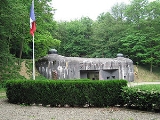
Maginot Line
Overview
Minister of Defence (France)
The Minister of Defense and Veterans Affairs is the French government cabinet member charged with running the military of France....
André Maginot
André Maginot
André Maginot was a French civil servant, soldier, and Member of Parliament. He is undoubtedly best known for his advocacy for the string of forts that would be known as the Maginot Line.- Early years, to World War I :...
, was a line of concrete fortification
Fortification
Fortifications are military constructions and buildings designed for defence in warfare and military bases. Humans have constructed defensive works for many thousands of years, in a variety of increasingly complex designs...
s, tank obstacles, artillery casemate
Casemate
A casemate, sometimes rendered casement, is a fortified gun emplacement or armored structure from which guns are fired. originally a vaulted chamber in a fortress.-Origin of the term:...
s, machine gun posts, and other defences, which France
France
The French Republic , The French Republic , The French Republic , (commonly known as France , is a unitary semi-presidential republic in Western Europe with several overseas territories and islands located on other continents and in the Indian, Pacific, and Atlantic oceans. Metropolitan France...
constructed along its borders with Germany and Italy, in light of its experience in World War I
World War I
World War I , which was predominantly called the World War or the Great War from its occurrence until 1939, and the First World War or World War I thereafter, was a major war centred in Europe that began on 28 July 1914 and lasted until 11 November 1918...
, and in the run-up to World War II
World War II
World War II, or the Second World War , was a global conflict lasting from 1939 to 1945, involving most of the world's nations—including all of the great powers—eventually forming two opposing military alliances: the Allies and the Axis...
. Generally the term describes only the defences facing Germany, while the term Alpine Line
Alpine Line
The Alpine Line or Little Maginot Line was the component of the Maginot Line that defended the southeastern portion of France...
is used for the Franco-Italian defences.
The French established the fortification to provide time for their army to mobilise in the event of attack, allowing French forces to move into Belgium for a decisive confrontation with German forces.

